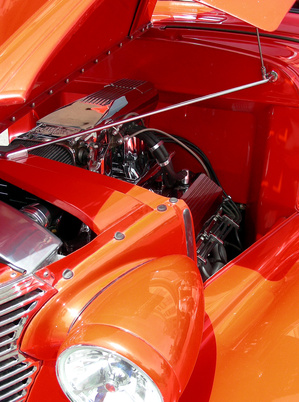
Holley Fuel Systems offers a broad lineup of aftermarket carburetors for almost every type of passenger vehicle engine. Holley carburetors are some of the best-performing units in the industry. Despite this reputation, Holley carburetors, with time and use, may develop issues. While Holley offers warranty options for all its new equipment, you still want to troubleshoot the device before pursuing a warranty claim.
Start your vehicle. If the engine will not start or turn over, you probably have a blocked fuel line. Check the fuel line delivery system. If the engine starts but dies immediately or after a few seconds, the choke may not be closing or is set improperly. Other signs the choke may be set wrong include the vehicle dying at low idle or revving high and then dying. If, after starting, it revs up high and stays high in park or neutral, the idle is set too high.
Run the vehicle for 15 to 20 minutes. After running it for a few minutes, if the RPM remains high and you have lots of black smoke, or the engine dies, the pull-off diaphragm or power valve may be damaged. You could also have a serious vacuum leak in the lines or carburetor.
Turn the vehicle off and restart it. If you are unable to restart the vehicle after it has warmed up, the choke may be staying closed when the engine is hot. If it dies after a few seconds, the power valve or venting system is inoperative.
Drive the vehicle after letting it warm up. Hesitations or stumbling with a light throttle indicate a vacuum leak, bad accelerator pump, a damaged idle solenoid, a stuck heated air inlet or a stuck EGR valve. Black smoke or choppy running indicates a blown power valve. Hesitation or dying under heavy throttle indicates a bad accelerator pump, stuck metering rods or a power valve, or the secondary air valve is set wrong. If the vehicle is idling fine but dies when stopping, you have a bad throttle positioner or defective float.
Turn the vehicle off and allow it to cool, then test-drive the vehicle. Engine stall, when engaging the transmission, indicates the choke pull-off or fast idle is set too low or a potential vacuum leak. Stumbling or hesitation, while driving, points towards a vacuum leak or improperly set choke. It could also mean the vacuum tubes are hooked up incorrectly. If you notice hesitations or stalling after driving the vehicle for a few minutes, a defective electronic assist, accelerator pump or ignition condenser could be the cause. Backfiring from a cold engine implies a plugged heat crossover system or a defective heat shroud duct or manifold vacuum supply.